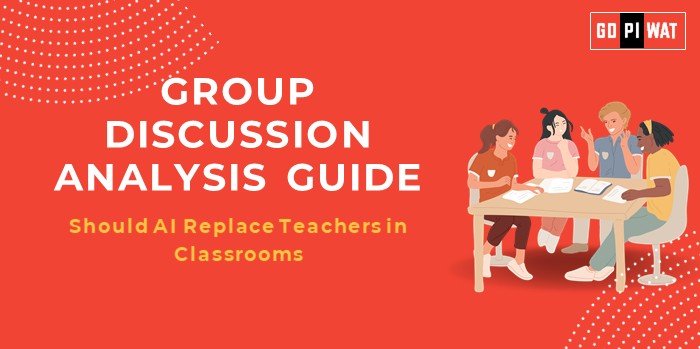📋 Should AI Replace Teachers in Classrooms?
🌐 Group Discussion Analysis Guide
🌟 Introduction to the Topic
🔍 Opening Context: Artificial Intelligence (AI) is revolutionizing industries like healthcare and finance, and the education sector is no exception. AI-powered tools offer personalized learning, automate tasks, and improve accessibility. But the question remains: can AI replace teachers entirely?
📌 Background: While AI systems like adaptive learning platforms and virtual tutors optimize education delivery, teachers provide human interaction, empathy, and mentorship, which machines cannot replicate.
📊 Quick Facts and Key Statistics
- 🌍 Market Size: AI in education is projected to reach $7 billion globally by 2024.
- 📈 Impact on Learning: AI tools have improved student performance by 30% in trials.
- 🏫 Teacher Shortage: UNESCO estimates a global need for 69 million teachers to achieve universal education goals.
- 🖥️ AI Adoption: 40% of schools in developed countries already use AI in classrooms.
👥 Stakeholders and Their Roles
- 👩🏫 Teachers: Impacted by AI automation, shifting their roles to facilitators and mentors.
- 👨🎓 Students: Benefit from personalized education but risk losing emotional connection with human teachers.
- 🏫 Institutions: Integrate AI tools while balancing pedagogy with technology.
- 💻 Tech Providers: Develop and optimize AI-driven solutions for education.
🏆 Achievements and Challenges
✅ Achievements
- 🎯 Personalized Learning: AI tailors content to individual learning speeds and styles.
- ⚙️ Administrative Efficiency: Automates grading and scheduling, reducing teacher workload.
- 🌍 Global Accessibility: Platforms like Duolingo and Khan Academy democratize quality education.
- 📊 Data-Driven Insights: Real-time analytics help educators identify student learning gaps.
⚠️ Challenges
- ❤️ Lack of Emotional Connection: AI cannot replicate mentorship and empathy.
- 🌐 Digital Divide: Limited access to technology in rural areas.
- 🔒 Ethical Issues: AI raises concerns about data privacy and algorithmic bias.
- 👨🏫 Job Displacement: Automation threatens traditional teaching roles.
🌍 Global Comparisons
- 🇫🇮 Finland: Uses AI as a supplement, maintaining teacher-centered models.
- 🇰🇷 South Korea: Implements AI-powered tutoring systems with human oversight.
📖 Case Study
🌟 China’s Squirrel AI: Adaptive learning techniques have led to a 20% improvement in student test scores, showcasing AI’s potential when used effectively.
🔄 Structured Arguments for Discussion
- ✅ Supporting Stance: “AI can personalize education better than human teachers, ensuring every student learns at their own pace.”
- ⚠️ Opposing Stance: “Teachers provide emotional guidance, moral values, and social skills that AI cannot replicate.”
- ⚖️ Balanced Perspective: “AI should complement, not replace, teachers, enabling blended learning models for holistic education.”
🎯 Effective Discussion Approaches
- 📊 Statistical Insight: “AI has improved student performance by 30%, showing its efficiency in personalized education.”
- ⚖️ Contrast: “While AI excels in scalability, it cannot replace a teacher’s role in emotional support and mentorship.”
- 🌍 Case-Based: “Countries like Finland successfully integrate AI alongside human teachers for optimal results.”
📝 Strategic Analysis of Strengths and Weaknesses
- ✅ Strengths: Scalability, efficiency, and personalized learning.
- ⚠️ Weaknesses: Emotional detachment, ethical concerns, and lack of human interaction.
- 🚀 Opportunities: Teacher-AI collaboration and EdTech innovation.
- ⚡ Threats: Teacher job losses and inequality due to the digital divide.
💼 Connecting with B-School Applications
- 🚀 Real-World Applications: Analyzing EdTech business models and policy-driven AI implementation.
- 🎤 Sample Interview Questions:
- 🔹 “How can AI and teachers complement each other in improving education quality?”
- 🔹 “What are the implications of AI replacing traditional teaching roles?”
- 📊 Insights for B-School Students:
- 🔹 Explore AI-driven education startups or digital inclusion policies.
- 🔹 Understand operational challenges in integrating AI into classrooms.
📝 Final Takeaways
- 🤖 AI enhances efficiency and personalization but cannot replace human empathy and mentorship.
- ⚖️ A balanced, blended learning approach ensures the best outcomes for students.
- 🌍 Global success stories like Finland prove that AI works best as a complement to teachers, not a replacement.


